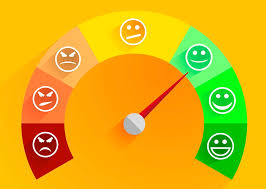Hello!
You need more than a high-quality product to grow a small business into a major player in your industry. You need customers who love what you’re doing and will follow you wherever you go. One way you do this is by cultivating high customer satisfaction.
What is Customer Satisfaction?
Customer satisfaction (often abbreviated as CSAT) is a measurement of how happy (or unhappy) customers are with a company's products, services or experience, Indeed explains.. “Customer satisfaction consists of a customer's perceived quality, value and expectations of your company and what you offer. This data can reveal major insights into how customers relate to your brand and how they will interact with your brand in the future.”
 To determine CSAT within your business, you have to take factors into account:
To determine CSAT within your business, you have to take factors into account:
Who is the customer?
What does it take to satisfy the customer?
In most businesses, there are multiple answers to that first question. Rarely is there only a single customer. There are typically a handful of target customers with slightly different wants, needs, and expectations. It’s up to you to differentiate your customer base. Then you can explore the specific ways in which your business can satisfy each sub-group.
Why Does Customer Satisfaction Matter?
It seems like an obvious question, but the answer isn’t nearly as simple as you might think. Customer satisfaction is important for a variety of reasons. Until you understand just how integral it is to your business’ score, you’re unlikely to take it as seriously as you should.
Here are a few of the specific reasons CSAT matters so much:
 CSAT segments your customers. At the very least, you must be able to filter your customers into two buckets: satisfied and unsatisfied. Because regardless of what other factors are in play, these two groups have to be treated differently. Satisfied customers can be presented with specific calls-to-action and be reasonably expected to respond in a positive manner. Unsatisfied customers, on the other hand, must be understood and communicated with in such a way that minor issues can be resolved and new, highly-targeted offers can be made to bring them back into the fold.
CSAT segments your customers. At the very least, you must be able to filter your customers into two buckets: satisfied and unsatisfied. Because regardless of what other factors are in play, these two groups have to be treated differently. Satisfied customers can be presented with specific calls-to-action and be reasonably expected to respond in a positive manner. Unsatisfied customers, on the other hand, must be understood and communicated with in such a way that minor issues can be resolved and new, highly-targeted offers can be made to bring them back into the fold.
CSAT helps you prioritize. When you have a clear idea of your customer satisfaction levels, you can prioritize where your team spends its time and money. If, for example, your customers are highly satisfied, it’s an indication that you’re doing things right. By staying committed to the same approach (with gradual improvements), you’re likely to continue generating positive results. If customers are dissatisfied, it indicates your priorities need to shift in such a way that you can quickly address shortcomings.
CSAT fuels new growth. High levels of customer satisfaction can produce customer reviews and other forms of social proof, which ultimately leads to positive word of mouth, referral traffic, and new business.
CSAT guides innovation. A quick look at CSAT can guide new product updates and releases. It’s a great barometer for innovation and helps identify clear and discernable areas for improvement.
And that’s just the start. If you take the time to conduct an honest and in-depth analysis of the DNA of your organization, you’ll discover few (if any) areas that customer satisfaction does not touch. Thus if you want to grow your business, CSAT is a logical place to start.
5 Ways to Improve Customer Satisfaction
Increasing customer satisfaction is an important yet challenging feat. The sooner you begin making an investment, the more likely you are to see positive gains.
Here are a few suggestions:
1. Prioritize Customers
 Customers have to be the priority from the very start; otherwise, you’ll never establish a sustainable business that propagates repeat customers ( which is where real growth occurs).
Customers have to be the priority from the very start; otherwise, you’ll never establish a sustainable business that propagates repeat customers ( which is where real growth occurs).
Too many businesses get caught up in things like profit margins and upsells too early on in the process. And while profitability is a huge sticking point, it’s not nearly as important as cultivating a raving customer base in the early stages of growth and development.
If you prioritize customers and establish a base of people who are crazy about your products and services, you’ll eventually be able to name your price. It’s about putting the correct foundation in place today so that you can build the business you want tomorrow.
Whether it’s the company’s mission statement and core values, sales training, or creative marketing and branding work, every aspect of your business must hold customers as the number one priority.
2. Gather Insights from Customers
 It’s easy for entrepreneurs and business owners to assume they know how their customers are feeling. However, it’s easy to become blinded by your own bias. The only way to know is by gathering data and feedback straight from the customers themselves.
It’s easy for entrepreneurs and business owners to assume they know how their customers are feeling. However, it’s easy to become blinded by your own bias. The only way to know is by gathering data and feedback straight from the customers themselves.
There are a variety of ways to gather insights from customers, but you need to use a method that’s quantifiable. A survey with answers graded on a scale of 1 to 5 is the easiest approach. And based on this, you can calculate a customer satisfaction score.
To calculate your score, take the total number of satisfied customers (anyone rating you a 4 or 5) and divide that figure by the total number of responses. Then multiply the final number by 100. This will give you a CSAT within a 0-100 range.
Total # of Satisfied Responses
----------------------------------- X 100 = CSAT Score
Total # of Responses
If, for example, you have 57 satisfied customers out of 100, your CSAT score would be 57.
In order for CSAT to become a powerful metric, it’s important that you track it over time. By recording and plotting it every month, you’ll eventually see a trend emerge. And then, based on whether things are moving in a positive or negative direction, you can implement necessary tweaks and changes.
3. Hire the Right People
 You can have the best plans, processes, and core values in place, but it ultimately comes down to execution. And in order to execute, you need the right people on your team.
You can have the best plans, processes, and core values in place, but it ultimately comes down to execution. And in order to execute, you need the right people on your team.
High-level customer satisfaction is impossible without the right people on your team. As you build your team and make new hires, be sure you’re prioritizing the right skills and traits. This includes:
Communication. Your employees are your voice. They’re the ones on the front lines - interacting with customers, smoothing over points of friction, and delivering value. Hire employees with exceptional communication skills and you’ll give your business a massive advantage.
Empathy. There’s a saying in customer service that you should hire for empathy and train for everything else. That’s because true empathy is a rare trait to find (and it’s impossible to teach).
Self-Motivated. There isn't enough money or perks to continually motivate an employee to put customers first. At some point, an employee has to reach down deep inside themselves and feel a genuine desire to prioritize customer satisfaction. Hire self-motivated people and you won’t have to spend as much time coaxing your team into a specific direction.
If you can hire employees who tick off each of these three boxes, you’ll discover that positive customer satisfaction becomes a natural byproduct.

4. Create a Knowledge Base
We live in a DIY world where people are fine doing something themselves - as long as it’s quick! In fact, research shows that 40 percent of customers prefer self-service. And one of the top ways to provide self-service options to customers is to create a robust knowledge base.
A knowledge base is essentially a massive library of self-help, tips, guides, tutorials, and FAQs that customers can access at any time in order to find solutions to common problems. This knowledge base is typically stored on your website, but can also be provided to customers as part of the product. (Many software solutions have some type of knowledge base feature built in.)
As a side note, a knowledge base does not replace customer service. There will always be a need for direct interaction with customers. The knowledge base simply provides a self-service option. You’ll need more involved customer service strategies in place to support customers who need further attention.
5. Implement Omnichannel Support
 Today’s customers expect you to be there for them 24/7/365. They also expect you to communicate with them in their own preferred medium or mode of choice. Thus, it’s important to have omnichannel support in play.
Today’s customers expect you to be there for them 24/7/365. They also expect you to communicate with them in their own preferred medium or mode of choice. Thus, it’s important to have omnichannel support in play.
At the very least, you need to be reachable by phone, email, and social media. If that sounds impractical given your constraints, look into some sort of AI chatbot platform to reduce the number of people you need on call. (Facebook, for example, has built-in AI tools that you can use to streamline this aspect of your customer service.)
Also read:
- How to Challenge Your Brain to Learn Easily
- Best Job Oriented Courses After Graduation
- China Alleges Nvidia Embedded Backdoor in H20 Chip Designed for Chinese Market
Invest in Sustainable Growth
There are thousands of ways to grow your business and transform it into a thriving one. However, the only way to achieve sustainable growth is to put the customer first. By emphasizing customer satisfaction from the very start, you can set your fledgling company up for years of success. Utilize the tips outlined in this article as a starting point. And no matter where you go from here, always remember to prioritize the customer’s wants, needs, and expectations every step along the way.
Thank you!
Subscribe to our newsletter! Join us on social networks!
See you!






